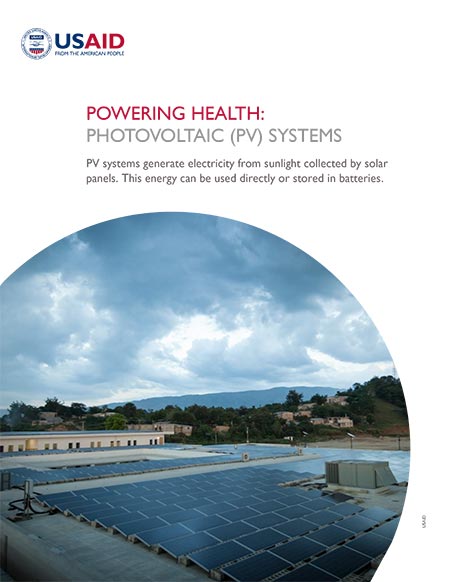PV systems generate electricity from sunlight collected by solar panels. This energy can be used directly or stored in batteries.
PV systems have been successfully deployed all over the world for decades in a variety of applications, including power for remote weather stations and telecommunications towers, residential installations, community micro-grids, and grid-scale power plants. Perhaps the greatest advantage of PV technology in meeting such a wide range of applications is scalability. PV systems can be designed to meet nearly any power requirements and can work in conjunction with diesel generators, the grid, battery banks, or any other power source to provide stable, continuous power.
A successful PV installation will provide power for more than 20 years with no fuel costs and little maintenance. When compared to diesel generation in particular, PV is a cost-competitive option, especially in the developing world where electricity and diesel prices are often high. Although PV technology is an appropriate choice for many applications in the developing world, high capital costs and poor installation and maintenance practices have been limiting factors in the overall deployment of photovoltaics. The discussion of photovoltaic systems in this document is meant to convey basic information on PV technology as well as best practices in the design and implementation of such systems, especially in the context of health facilities in the developing world.
The Role of Solar Power in Health Facility Energy Systems
Solar power offers numerous benefits to health facilities of all types but especially to those with little or no access to grid electricity. Photovoltaics produce no pollutants, require no fuel, and need little maintenance. When economically viable, they are a good option for any health facility energy system. PV systems are of special importance to remote facilities that do not have access to grid power. In such locations, options for power generation are few—usually diesel or PV generation. Often the most economical off-grid solution is a hybrid diesel-PV energy system, which makes the most of either resource at the most appropriate time. Compared to a diesel-only scenario, a diesel-PV hybrid will likely save significant fuel costs over the life of the system. Therefore, PV systems help to ensure the long-term financial sustainability of health clinics by shielding them from fluctuations in fuel supply and cost.
PV System Components
Photovoltaic systems are made up of much more than just PV solar panels. There are a whole range of other system components, referred to as the balance of system (BOS), which include inverters, combiner boxes, wiring, mounting/racking, battery banks, etc. While these are major PV system components, the list is not exhaustive. An installed system will likely involve other minor components. The makeup of any PV system depends on the type of load it powers and, more importantly, whether it is connected to the grid.
Costs
The costs associated with a solar PV system are generally put into terms of the system’s capital cost, and the cost of energy produced by the system over its life. Only a portion of this cost can be attributed to the PV panels. The remaining costs are for BOS materials (mounting hardware, inverters, batteries, etc.), engineering design, labor, and other materials and services. If the system has no other backup power, a battery bank must be sized appropriately to provide power after several days of overcast weather; therefore, local weather patterns can influence overall system cost. Unusual expenses such as transportation of modules, customs fees, and permitting expenses can increase this cost even further.
Sizing
Properly sizing a solar PV system requires careful attention to detail and thoughtful planning. Solar system sizing is a step-by-step process that accounts for facility energy needs and the local solar resource in order to determine the necessary size of the solar array. The process outlined in the document is a guide to estimating the size of a solar installation.
Maintenance
Solar PV panels are low maintenance, but a regular and organized maintenance program is still absolutely essential to system longevity. The panels themselves typically have a very long lifetime, 20–30 years. Unfortunately, installation programs do not always include a sufficient service component. Health facilities with solar panels must have a vigorous training program for local users and an established maintenance protocol.
Additional Resources
-
Load Calculation and System Optimization
This exclusive online version of the HOMER Powering Health Tool evaluates hybrid power systems to determine the most cost-effective options for delivering continuous electricity to health facilities. Use the tool
-
USAID
Analyze Energy Demand and Supply
Before investing in any energy technologies, a health facility must first understand its current day-to-day energy requirements. An initial energy audit is critical to ensuring proper system design and operation. Learn more
-
USAID
Photovoltaic System Standards
Many organizations have established standards that address photovoltaic (PV) system component safety, design, installation, and monitoring. View the standards


Comment
Make a general inquiry or suggest an improvement.